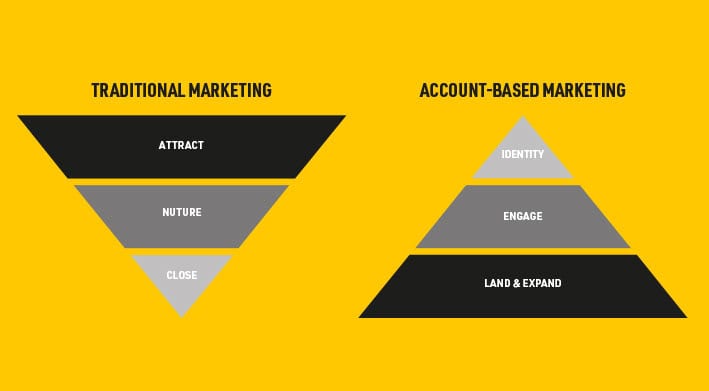What if we said forget your lovely big pile of sales leads – just concentrate on a handful? Sound counter-intuitive? Downright terrifying? Welcome to Account Based Marketing (ABM). Like so many things, it’s not at all scary once you understand how it works. In fact, ABM could be your best friend – for one thing it’s credited with turbo-boosting ROI for B2B marketing. The premise is simple: by focusing your resources on winning best-fit, high value accounts, you stand a better chance of success. It’s the inbound marketing funnel, flipped upside down. Intrigued? Want to learn what you need for a successful ABM campaign? Then read on…

If you’re still dubious about the merits of Account Based Marketing, take a look at these figures. The internet’s awash with further evidence, so feel free to do your own research.
Increased ROI is a big attraction of ABM, but it’s not the only one. If you need some more convincing, here are a few more reasons to think about getting on board.
Marketing Sales alignment
Close collaboration between teams is always a good thing. ABM marries Sales and Marketing, (inevitably labelled ‘smarketing’). When both departments have the same goals and work together to identify prospects, create customised campaigns and nurture accounts, you get powerful alchemy between two different teams. Combine that with ABM… and magic happens…
Shorter sales cycles
With account-based marketing, you can nurture all prospects within a target account simultaneously. This saves time – you don’t have to wait for major purchase decisions to make their way from the lower levels of an organisation to senior leaders.

Fewer wasted resources
Because the accounts you focus on are those that are most likely to generate revenue, you’re making the best use of your time and resources. It’s maximum ROI and minimum waste. Simple as ABC.
Greater engagement
One of a marketer’s most difficult tasks is getting potential customers to engage. After all, they’re bombarded with sales messages every day – no wonder they’re immune. With ABM, the marketing is so personalized that targets can’t ignore it. When everything’s built around you, interaction happens naturally.
Clearer ROI
ABM doesn’t just generate higher ROI; it also makes ROI easy to measure. You can quickly see the return on investment for each account that you’ve targeted. If your ROI proves that your ABM tactics work, this information can drive your future strategy and bring continuous improvement to revenue. Gather data, track the stats and watch the gains grow.

There are three main methods of ABM. When choosing the one you’ll use, think about your business, the type of accounts you want to target, deal size and lifetime value.
One-to-one
This is where you select a small number (1-5) of high value accounts and pour all your budget into targeting them.
One-to-few
This option is sector-specific: you pick a larger pool of higher value accounts (10-30) from the same industry.
One-to-many
With this method, you aim for 30-plus lower value accounts. That means one-to-many is like traditional techniques, but with more customised messaging.
Once you know what method you’ll use, you’ll need to think about tactics. It’s a case of looking at the segments you’re targeting and personalising your marketing via suitable channels. Maybe your ABM strategy will be digital heavy, with email, paid advertising and web personalisation. Or perhaps you’ll need to mix it up with offline channels such as events and direct mail. The exact blend will be unique to your business – there’s no one size fits all. Here are a few Account Based Marketing examples of tactics for different channels.
Email marketing campaigns
You’re going for quality, not quantity – so no more cookie-cutter emails, sent to hundreds of prospects. With ABM, you create bespoke digital marketing messages that have been thoughtfully tailored to each target account.

Paid advertising and social media channels
PPC and paid social media ads enable you to target (and retarget) specific companies and personas. This is a fantastic tool – just customise your content to your viewers, and hey presto – account based advertising.
Web personalisation
Once people arrive at your website, what will they see? If you’ve got your ABM hat on, they’ll enjoy a user experience that’s designed just for them. Today, website personalisation technology can identify key visitors and adapt your site to appeal to them: offers, content, messages… Yep, tech’s amazing.
Direct mail
The convenience and lower cost of digital meant a big shift towards email. But now, everyone’s inbox is overflowing and we’re all allergic to spam. That means direct mail is experiencing a renaissance – but this time it’s being used in a more considered, targeted way. Personalised gifts and marketing sent to prospects can grab their attention, and also be higher value, as the potential gains are much greater.
Events
Events, physical and virtual, are an ever-popular way of reaching B2B prospects. Where ABM is concerned, think personalised invitations, VIP dinners or mini-events, specially selected gifts and a personal follow-up.
Webinars
These can be adapted in much the same way as events. You can show special content online that’s designed just for your target audience.

Case studies and white papers
Make sure you get more bang for your buck when it comes to case studies and similar materials. Tailor generic content to emphasise the points that matter to your target audience.
If everything’s made sense so far, you may be ready to launch your own ABM program. Start small, perhaps with a pilot programme. ABM is an art.
ABM campaigns aren’t possible unless Sales and Marketing are both on board and these teams work together. The most obvious way to achieve this is to showcase the value of ABM. Stats and case studies are a good place to start, but what can really win hearts and minds is showing the way ABM works. For example: although Sales teams will be working with fewer leads, the lead generation will be of higher quality, which means they’re more likely to result in account wins: ker-ching! Once you’ve united the team and explained ABM, make sure everyone’s aware of key factors: budgets, resources, goals and KPIs.

Focusing on specific accounts is what ABM’s all about. But first you have to decide which ones you should target. An Ideal Customer Profile (ICP) is a picture of your dream customer, the one that would be the best fit for your business. To figure out your ideal match, you need to get specific. Looking at current clients and existing data, develop a set of characteristics. For instance, your most successful and profitable partnerships might be with companies of a certain size, in a certain sector or geographic location, with a certain budget and annual revenue. You might also find that on a personal level, you chime best with certain types of people with certain values and particular ways of working. You can get this information from company websites, review sites such as Trustpilot, your own data platforms and by talking to your team. Amalgamate the information to build your ICP description.
Got your ICP? Found some potential targets? Now you need to do your homework. It’s crucial to find out who the big players in your chosen accounts are – the movers and shakers within the company. Who are the decision makers? Who are the gatekeepers? What are the company’s goals? You need to understand the accounts in general so you can target them correctly.
Once you’ve got all your insights and data, it’s time to put them to work. Use the information you’ve collected to build a strategy that’s unique to your target accounts. Think about how you’ll personalise content and what tactics you’ll use. The list of channels above is a good starting point.
You’ve identified your target account and masterminded an ABM strategy. Now, it’s launch time – get ready to think bespoke. Successful delivery of your campaign depends on customising everything in a way your chosen account will like. Choose the target, be the target. Put yourself in their shoes.

Once you’ve got the show on the road, it’s time to analyse the data. You need to monitor the metrics you’ve chosen to spot any problems and ensure your strategy’s effective. Think about deal creation, account penetration, deal-to-close time, net-new revenue, percent of deals closed, and crucially, engagement. Watch all channels closely to make sure you’re building meaningful relationships.
To help you with the complexities of Account Based Marketing, there’s some excellent tech out there. You will certainly need decent foundational platforms in place, such as a CRM and Marketing Automation Platform (Salesforce and HubSpot are two popular choices). Looking beyond this, there are plenty of other clever tools out there for every aspect of ABM. Here are a few of the better-known ones.
Yes, we know – Account Based Marketing looks like a whole lot of work. You need to invest time and money in aligning your sales and marketing teams and conducting research, while focusing on an alarmingly small number of accounts. However, as the stats show, your efforts are likely to pay off with some big account wins. ABM is putting all your eggs in one basket – but giving them VIP treatment.
If you aren’t feeling confident enough to take on ABM yourself, we’re happy to hold your hand. Our experts can answer all your questions and guide you through the process. Just get in touch with us.